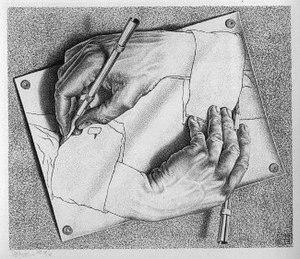 Drawing Hands is a lithograph by M. C. Escher. It shows a peice of paper out of which two increasingly detailed hands rise and draw eachother into existence. Escher uses a number of creative techniques to achieve his effect: the hands become more detailed and shaded closer to the palm and are simpler and more cartoonish at the wrist. This is used to both create and challenge our illusion of realism. The hands are both the object and method of creation.
Drawing Hands is a lithograph by M. C. Escher. It shows a peice of paper out of which two increasingly detailed hands rise and draw eachother into existence. Escher uses a number of creative techniques to achieve his effect: the hands become more detailed and shaded closer to the palm and are simpler and more cartoonish at the wrist. This is used to both create and challenge our illusion of realism. The hands are both the object and method of creation.
The lithograph signifies mutual constitution; that is, the principle of one entity being formed by the other and vice versa (like predator–prey co-evolution). However, our minds cannot reconcile how the picture emerged in the first place. If we were to imagine that this lithograph was a dynamic work where the hands would continue drawing themselves, we could easily imagine how the work would end up looking but we could not go back in time and figure out where the first hand came from. It depicts a simple creation paradox where neither hand seems to have an origin (see the post on Terminator Time Travel for another paradox which appears to have no origin point).
In Escher's lithograph, the paradox is effective at pointing out the unreality of the image. Like many surrealists works, the image is more effective at defining how the unreal works than the real. The image we are shown does not depict the rules of our world, instead it shows us the magical rules of art--where gravity can be defied, perspectives need not add up and two hands may draw themselves into existence (many of these themes appear in Escher's other work which display fantastic but impossible landscapes). In the world of Drawing Hands, creation doesn't require an origin--like Athena springing from Zeus' forehead, it can be spontaneous. So long as both hand draws the other, we can understand how the image exists by its rules if not ours.

Great Analysis
ReplyDeleteBeautifully analysed.
ReplyDelete